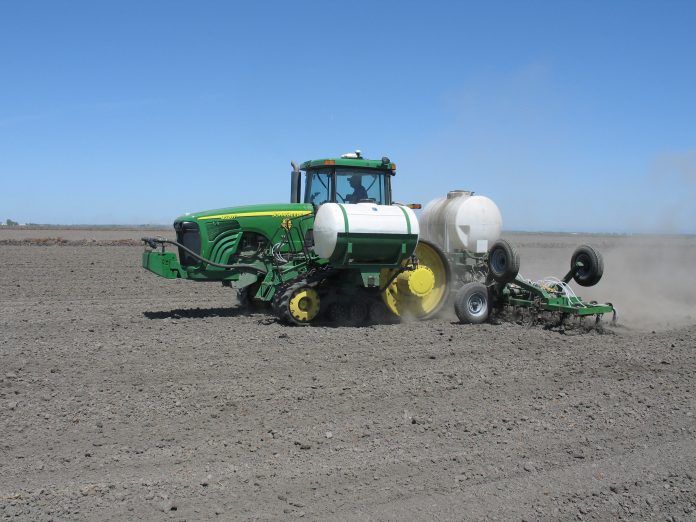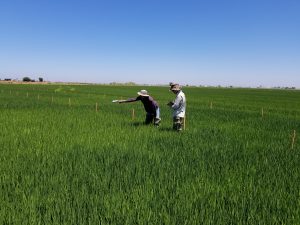
Most rice in California is established and grown in what is referred to as a water-seeded system. In this system, after the field is tilled and leveled, most (70% to 100%) of the nitrogen (N) is applied as aqua-ammonia (aqua) injected 3 to 4 inches below the soil surface. After this, the field is flooded and then aerial seeded by airplane. The field stays flooded, resulting in anaerobic (low oxygen) soil conditions. The deep placement of fertilizer and the anaerobic soil conditions protect the fertilizer N from gaseous losses due to ammonia volatilization or nitrification/denitrification. Very little of this preplant N fertilizer is taken up by the crop during the first month, so it needs to be well protected by the flood layer. Using this practice, fertilizer N is used very efficiently. In addition to this preplant aqua-N, some starter N (containing P, K and other nutrients) are applied early in the season, and a top-dress N may be applied mid-season.
What if Aqua is Not Available?
While this strategy has proven to be efficient and effective, there are situations where it may not be possible to apply aqua. For example, in recent years, supply chain issues have limited the availability of aqua. Also, heavy rain following seedbed preparation (but before fertilizer application) makes it difficult and inefficient to apply aqua. It is not advisable to apply aqua into a moist soil. Not only is it difficult for the equipment on wet clayey soils, but the aqua will start to nitrify (convert from NH4 to NO3) in moist soils, resulting in nitrate accumulation which will denitrify (NO3 lost as N2 gas to atmosphere) when the field is flooded.
So, what is a grower to do if aqua is not available? We evaluated six products applied at different times (19 treatments) at two locations in 2020 and 2021. The products included aqua, urea, ammonium sulfate and three enhanced efficiency N (EENF) fertilizers (Super U, Agrotain or Agrocote). We applied the products at a single dose at various times including preflood, one day, one week and two weeks after flooding. We also had a split application where the N rate was split and applied at four different times during the season.
Some general findings were that aqua or urea applied to a dry soil before flooding resulted in the highest yields at harvest. This confirms other earlier findings we have made. Ideally, if urea is used, it should be worked into the soil with a harrow before flooding, although if urea is applied to a cloddy soil, the urea granules tend to fall deeper into the soil via gaps between clods. It is important that urea is applied to dry soil so that the N fertilizer does not start to nitrify before field is flooded and to avoid ammonium volatilization.
Our second major finding was if a preflood application to a dry soil is not possible, the next best scenario is to split the N rate. The total N rate split at 15%, 35%, 35% and 15% at three, four, five and six weeks, respectively, after planting will likely give the best results. The idea behind split applications is that the fertilizer is being applied when the crop needs it most. This results in rapid fertilizer N uptake and lowers the chances for significant N losses. However, the fertilizer N is being broadcast into the flood water, and this may result in some volatilization and denitrification losses. At one of our sites, the data suggested if one were to split the N, the total N rate may need to be increased compared to aqua or urea applied before flooding.
Third, using the EENFs, such as Super U, Agrotain or Agrocote, had no benefit over applying urea alone. They did not improve yields, and in some cases, yields were reduced. These are expensive fertilizers, and we found no additional benefit to their use.
Finally, using ammonium sulfate did not affect yields compared to using urea. In our studies, we applied sulfate fertilizer to make sure S was not limiting. In soils deficient in S, applications of ammonium sulfate may be of benefit.

Decide if Top-Dress N is Necessary
We recommend applying the full rate of N at the beginning of the season in the aqua and starter fertilizer application. Regardless of the basal strategy, including those just discussed, top-dress N applications are needed if the plant is N deficient or you suspect it will become so. At PI (45 to 55 days after planting), the crop should be accessed to determine if a top-dress of N fertilizer is necessary. A good assessment is important because not applying N when needed can lead to a reduction in yield; however, applying N fertilizer when it is not needed can lead to lodging, delayed maturity, increased incidence of disease and reduced yields. The GreenSeeker (or similar instrument), which measures the NDVI (Normalized Difference Vegetation Index) of the canopy, is a tool we have tested for this purpose. The best way to do this is to develop a Sufficiency Index (SI). The sufficiency index is calculated using the NDVI reading from the field test area divided by the NDVI from an enriched N strip (representing a crop with unlimited N.) The N-enriched strip is an area where extra N was added to the field (could be done by overlapping an area with an aqua rig or a small area where you intentionally added extra N.) The SI will be a number between 0 and 1. The lower the SI, the more N-deficient. For example, if the N-enriched strip gave an NDVI value of 75 and the field test area gave an NDVI value of 69, the SI would be 0.92 (69/75 = 0.92). Our research has indicated it is cost-effective to apply a top-dress of N fertilizer when the SI is below 0.95, although this depends on the price of rice and cost of applying fertilizer. This could also be done using a drone which would cover a larger area. If using a drone, we recommend using a camera that can measure NDRE (Normalized Difference Red Edge). We have found NDRE to be more precise than NDVI when quantifying the nitrogen status of a crop.
More on this can be found on our website at https://rice.ucanr.edu/.
















